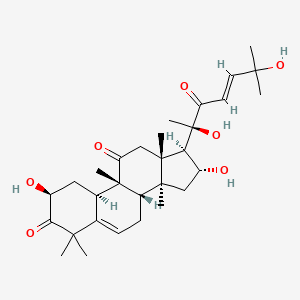| Authors | Title | Published | Journal | PubMed Link |
|---|---|---|---|---|
| Ku JM et al. | Cucurbitacin D induces cell cycle arrest and apoptosis by inhibiting STAT3 and NF-κB signaling in doxorubicin-resistant human breast carcinoma (MCF7/ADR) cells. | 2015 | Mol. Cell. Biochem. | pmid:26169986 |
| Jacquot C et al. | Cucurbitacin-D-induced CDK1 mRNA up-regulation causes proliferation arrest of a non-small cell lung carcinoma cell line (NSCLC-N6). | 2014 | Anticancer Res. | pmid:25202060 |
| Abbas S et al. | The cucurbitacins E, D and I: investigation of their cytotoxicity toward human chondrosarcoma SW 1353 cell line and their biotransformation in man liver. | 2013 | Toxicol. Lett. | pmid:23194827 |
| Ishii T et al. | Cucurbitacin D induces growth inhibition, cell cycle arrest, and apoptosis in human endometrial and ovarian cancer cells. | 2013 | Tumour Biol. | pmid:23150173 |
| Spear SA et al. | Natural compounds as potential treatments of NF2-deficient schwannoma and meningioma: cucurbitacin D and goyazensolide. | 2013 | Otol. Neurotol. | pmid:23928514 |
| Song Y et al. | Cucurbitacin D is a new inflammasome activator in macrophages. | 2013 | Int. Immunopharmacol. | pmid:24140411 |
| Ding N et al. | Apoptosis induction through proteasome inhibitory activity of cucurbitacin D in human T-cell leukemia. | 2011 | Cancer | pmid:21656752 |
| Jung ME and Lui RM | Studies toward the total syntheses of cucurbitacins B and D. | 2010 | J. Org. Chem. | pmid:20873743 |
| Sahranavard S et al. | New cucurbitane-type triterpenoids from Bryonia aspera. | 2010 | Planta Med. | pmid:20108178 |
| Abou-Khalil R et al. | Interaction of cucurbitacins with human serum albumin: Thermodynamic characteristics and influence on the binding of site specific ligands. | 2009 | J. Photochem. Photobiol. B, Biol. | pmid:19380237 |
Cucurbitacin D
Cucurbitacin d is a lipid of Sterol Lipids (ST) class. The involved functions are known as Transcription, Genetic. Cucurbitacin d often locates in Membrane.
Cross Reference
Introduction
To understand associated biological information of Cucurbitacin D, we collected biological information of abnormalities, associated pathways, cellular/molecular locations, biological functions, related genes/proteins, lipids and common seen animal/experimental models with organized paragraphs from literatures.
What diseases are associated with Cucurbitacin D?
There are no associated biomedical information in the current reference collection.
No disease MeSH terms mapped to the current reference collection.
PubChem Associated disorders and diseases
What pathways are associated with Cucurbitacin D
There are no associated biomedical information in the current reference collection.
PubChem Biomolecular Interactions and Pathways
Link to PubChem Biomolecular Interactions and PathwaysWhat cellular locations are associated with Cucurbitacin D?
Visualization in cellular structure
Associated locations are in red color. Not associated locations are in black.
Related references are published most in these journals:
| Location | Cross reference | Weighted score | Related literatures |
|---|
What functions are associated with Cucurbitacin D?
Related references are published most in these journals:
| Function | Cross reference | Weighted score | Related literatures |
|---|
What lipids are associated with Cucurbitacin D?
There are no associated biomedical information in the current reference collection.
What genes are associated with Cucurbitacin D?
There are no associated biomedical information in the current reference collection.
What common seen animal models are associated with Cucurbitacin D?
There are no associated biomedical information in the current reference collection.
